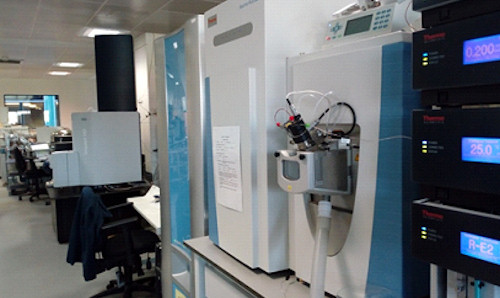Mass spectrometry laboratory
The mass spectrometry laboratory boasts a range of industry-leading instrumentations, available to use for staff, students and external companies on request.

The laboratory is housed in GE.003 in the Chemistry Building. It deals with more than 15,000 different types of samples every year. The staff of the laboratory develops new analytical techniques and methods and takes part in number of high impact research projects and international collaborations.
The laboratory is open weekdays from 8am to 4pm.
As part of the sample submission process, please download and complete our mass spectrometry request form.
More information on instrumentation and techniques is listed below:
Mass spectrometers and techniques available
- Shimadzu Biotech Axima Confidence, Time of Flight Matrix Assisted Laser Desorption Ionisation (MALDI) mass spectrometer
- Waters SQ detector, mass spectrometer, Electrospray/ APCI ion source attached to HPLC system
- Thermo Orbitrap Exactive Plus Extended Mass Range mass spectrometer, Electrospray, APCI, Photoionisation, SABR ion source, mass range to 50 000 amu, very high resolution
- Agilent GCMS system, "7890A series GC" attached to "5975C electron ionisation quadrupole mass spectrometer" and "GC Sampler 80" autosampler
- Agilent 6120 Quadrupole mass spectrometer, electrospray/ APCI ion source, low resolution.
- Waters SYNAPT ion mobility mass spectrometer, high resolution, coupled with range of lasers (266 nm, 800 nm femtosecond and others)
- Thermo Finigan MAT95XP, magnetic sector mass spectrometer, electron ionisation, high resolution
- Bruker Amazon ETD electrostatic trap mass spectrometer attached to Thermo HPLC system
- Bruker Impact HD quadrupole TOF attached to Thermo UltiMate3000 HPLC system (MS/MS capability)
Chromatographs
- Agilent Technologies 1260 Infinity (HPLC, we have five of these + one 1200 series, some of them are coupled with the mass spectrometers from the list above);
- Hewlet Packard 1100, HPLC;
- Thermo Scientific, Trace 1310 GC;
- Thermo Scientific, Master GC;
- Finnigan Forms GC.
Techniques and sample preparation
Electrospray (ES)
A good general technique. Good for polar organic or organometallic molecules, salts and acids. Atmospheric Pressure Chemical Ionisation (APCI) works better on non- polar compounds than ES.
For both ES and APCI submit about 0.1mgs of sample in the autosampler vial with the septum lid, (stores cat. no. Vial 100). Very dilute solutions are needed for these techniques. If too much sample is submitted the excess will be discarded. Only polar solvents can be used, usually methanol, acetonitrile or water. Either the positive or negative ion spectrum can be recorded, or both if you cannot decide which.
The SQD2 is normally run in ES mode and changed to APCI about once a week. Turnaround time for ES is 1-2 days, and up to a fortnight for APCI.
Electron impact/chemical ionisation (EI/CI)
This can be used for small organic molecules. Volatile samples can be run by GCMS and if needed later analysed on Thermo Finnigan MAT95XP using electron/ chemical ionisation for determination of accurate mass.
Matrix Assisted Laser Desorption Ionisation (MALDI)
Polymers, organometallics, proteins and high mass samples. Submit 0.5mgs or more of the solid sample in any small vial. Most solvents can be used. It is important to specify the mass range of interest on the form and put the highest likely mass into the login system.
Gas Chromatography Mass Spectrometry (GCMS)
GCMS can be used for the analysis of small volatile organic compounds. Please submit 1-2 mgs of sample in an auto-sampler vial with the septum lid (Vial 100). The sample will be initially attempted by GCMS however it may be necessary for the sample to be transferred to GC to establish chromatography conditions. The source in GCMS will be periodically swapped from Electron Impact (EI ) to Chemical ionisation (CI). Turnaround time will be variable depending on the workload.
High Resolution Accurate Mass Measurements
This technique is usually requested for identification of novel compounds or for data reported in a paper or a thesis.
To submit a sample, use the original request form with the spectrum attached, enter the details in the login system, change the log number on the form but leave the sample attached.
